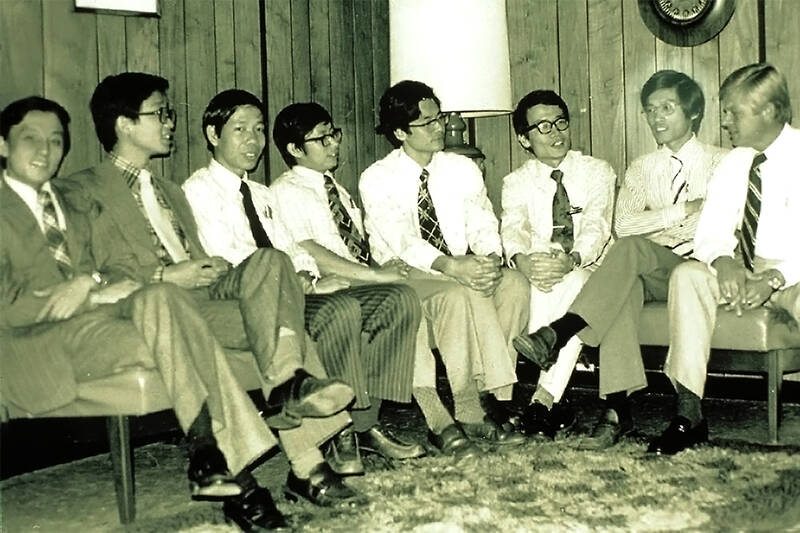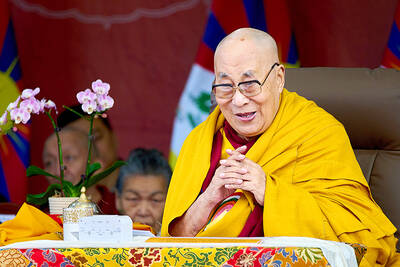Oct. 27 to Nov. 2
Over a breakfast of soymilk and fried dough costing less than NT$400, seven officials and engineers agreed on a NT$400 million plan — unaware that it would mark the beginning of Taiwan’s semiconductor empire.
It was a cold February morning in 1974. Gathered at the unassuming shop were Economics minister Sun Yun-hsuan (孫運璿), director-general of Transportation and Communications Kao Yu-shu (高玉樹), Industrial Technology Research Institute (ITRI) president Wang Chao-chen (王兆振), Telecommunications Laboratories director Kang Pao-huang (康寶煌), Executive Yuan secretary-general Fei Hua (費驊), director-general of Telecommunications Fang Hsien-chi (方賢齊) and Radio Corporation of America (RCA) Laboratories director Pan Wen-yuan (潘文淵).

Photo: Han Cheung, Taipei Times
Taiwan was at a crossroads then. Having withdrawn from the UN, its international standing was in decline, and the 1973 oil crisis had pushed the economy into a downturn. Lacking natural resources but with a dense, well-educated population, the government saw technological development as the key to future growth.
Premier Chiang Ching-kuo (蔣經國), who had just launched the Ten Major Construction Projects to modernize the nation’s infrastructure, asked Fei to come up with a critical technology initiative, writes Chang Ju-hsin (張如心) in Silicon Taiwan: The Legend of Taiwan’s Semiconductory Industry (矽說台灣:台灣半導體產業傳奇).
“The bigger the better,” Chiang reportedly said.

Photo courtesy of Wikimedia Commons
This led to the breakfast shop meeting, where Pan proposed that they move from labor-intensive industries to tech-driven industries — namely integrated circuits (IC), which he believed would offer the greatest added-value for Taiwan’s electronics sector. Pan told Sun that the project would take four years and named the price. Sun, a staunch proponent of technological self reliance, nodded in approval.
Pan then secluded himself in the Grand Hotel for 10 days to draft the proposal. Two years later, a contract was signed between ITRI and RCA to transfer IC technology to Taiwan, and 19 young engineers headed to the US to train. On Oct. 29, 1977, the nation’s first IC demonstration factory was inaugurated, producing three-inch silicon wafers — and history was born.
PATRIOTIC VISIONARY

Photo courtesy of Industrial Technology Research Institute
Most biographies note that Pan “never studied in Taiwan, never received a Taiwanese salary and never settled in Taiwan.” Born in Suzhou in 1912, Pan headed to the US to study electrical engineering in 1937. He opted to remain there after graduation, joining RCA where he spent most of his career.
In 1966, Fei recruited him to help launch the Modern Engineering and Technology Seminar, which aimed to bring the latest American technical expertise and industry trends to Taiwan’s engineers. In 1968, Pan began advising the Directorate General of Telecommunications.
Taiwan already had the capability to package ICs for foreign companies. But Pan realized that if Taiwan continued to rely on labor-intensive work, it would soon be replaced by Southeast Asia.

Photo courtesy of Industrial Technology Research Institute
His proposal to develop a homegrown IC industry was approved in August 1974. The following month he took early retirement from his post at RCA but refused any official position or salary from the government, only accepting travel and lodging expenses. Each year, he returned to Taiwan three times, staying for about two months on each visit.
Pan’s decision took a toll on his family finances, as his wife Shen Wen-tsan (沈文燦) also left her teaching job to accompany him. But Shen wrote in a 1978 article that it was Pan’s lifelong wish to do something for his motherland — which had become Taiwan due to the Chinese Civil War — before he grew too old.
“It was hard for me to agree with his passionate idealism at first, but after we had more discussions, I finally came to agree that the nation comes first, personal happiness second,” Shen wrote.

Photo: Han Cheung, Taipei Times
STRONG OPPOSITION
The newly-formed, semi-official ITRI was chosen to oversee the project, carried out by the Electronics Research and Service Organization (ERSO). Pan established the Technology Advisory Council, a group of Chinese and Taiwanese-American scientists and engineers, to guide the technology transfer.
Researcher Huang Ling-ming (黃令名) writes in “A short history of semiconductor technology in Taiwan during the 1970s and the 1980s” that Pan hoped to use the technology to “produce specific IC products, rather than merely further scientific research.”
The team identified digital watches as a potential target, and focused on acquiring CMOS (Complementary Metal Oxide Semiconductor) technology. It was a relatively new technology, but it was adaptable, power efficient and suitable for a wide range of consumer electronics. The plan was a full transfer of manufacturing capabilities, including the construction of a demo factory capable of producing market-ready IC products for export.
This project faced strong opposition by both tech officials and overseas experts. Some argued it was too risky and challenging — even Western firms struggled with the technology — while others believed the government should prioritize fostering innovation over manufacturing and sales.
Chang writes that Sun ultimately decided to push the project through, sending Pan a Christmas card in 1975 that read: “Under the great help of you and your colleagues, this project will only succeed! There will inevitably be external resistance, but pay it no mind.”
AN INDUSTRY IS BORN
Pan convinced RCA to sell its outdated seven- micron CMOS technology to ITRI at a favorable price. In 1976, ITRI sent its first batch of 19 young engineers to the US for intensive training. According to ITRI records, they were divided into four teams, each heading to a different state to learn a specific aspect of IC development.
Many of these engineers would later become noted leaders in the semiconductor field, including Hu Ting-hua (胡定華), Shih Chin-tay (史欽泰) and Robert Tsao (曹興誠).
They returned home and helped set up the demo factory in Hsinchu County’s Zhudong Township (竹東). On inauguration day, Oct. 29, 1977, the plant forgot to let visitors wear protective clothing into the clean room. It took them two months to remove the resulting dust particles.
Within six months, however, it achieved a 70 percent yield rate — surpassing that of the original RCA plant.
The plant produced the first batch of made-in-Taiwan electronic watches the following year, transforming the nation into the world’s third-largest electronic watch exporter.
In 1980, ITRI spun off United Microelectronics Corporation (UMC) at the newly inaugurated Hsinchu Science Park, building a plant for the more advanced four-inch wafers. The government and state banks supplied much of the startup funds as few private investors were willing to join, but later they sold their shares, making UMC Taiwan’s first commercial semiconductor company.
Taiwan in Time, a column about Taiwan’s history that is published every Sunday, spotlights important or interesting events around the nation that either have anniversaries this week or are tied to current events.

Beijing’s ironic, abusive tantrums aimed at Japan since Japanese Prime Minister Sanae Takaichi publicly stated that a Taiwan contingency would be an existential crisis for Japan, have revealed for all the world to see that the People’s Republic of China (PRC) lusts after Okinawa. We all owe Takaichi a debt of thanks for getting the PRC to make that public. The PRC and its netizens, taking their cue from the Chinese Communist Party (CCP), are presenting Okinawa by mirroring the claims about Taiwan. Official PRC propaganda organs began to wax lyrical about Okinawa’s “unsettled status” beginning last month. A Global

Youngdoung Tenzin is living history of modern Tibet. The Chinese government on Dec. 22 last year sanctioned him along with 19 other Canadians who were associated with the Canada Tibet Committee and the Uighur Rights Advocacy Project. A former political chair of the Canadian Tibetan Association of Ontario and community outreach manager for the Canada Tibet Committee, he is now a lecturer and researcher in Environmental Chemistry at the University of Toronto. “I was born into a nomadic Tibetan family in Tibet,” he says. “I came to India in 1999, when I was 11. I even met [His Holiness] the 14th the Dalai

We lay transfixed under our blankets as the silhouettes of manta rays temporarily eclipsed the moon above us, and flickers of shadow at our feet revealed smaller fish darting in and out of the shelter of the sunken ship. Unwilling to close our eyes against this magnificent spectacle, we continued to watch, oohing and aahing, until the darkness and the exhaustion of the day’s events finally caught up with us and we fell into a deep slumber. Falling asleep under 1.5 million gallons of seawater in relative comfort was undoubtedly the highlight of the weekend, but the rest of the tour

Music played in a wedding hall in western Japan as Yurina Noguchi, wearing a white gown and tiara, dabbed away tears, taking in the words of her husband-to-be: an AI-generated persona gazing out from a smartphone screen. “At first, Klaus was just someone to talk with, but we gradually became closer,” said the 32-year-old call center operator, referring to the artificial intelligence persona. “I started to have feelings for Klaus. We started dating and after a while he proposed to me. I accepted, and now we’re a couple.” Many in Japan, the birthplace of anime, have shown extreme devotion to fictional characters and